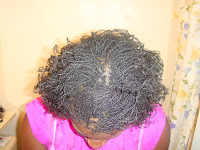
It has only been two weeks and I still have not shampooed my hair. My hair doesn't feel dirty, itchy, or heavy from product build up; however, mentally I feel like I need to wash my hair, I've been working out and sweating and spritzing maybe once a week. Like I posted earlier I bought the Jamaican Mango & Lime Tingle Shampoo, but i still don't want to use it. A fellow blogger asked me why and something is telling me not to use it, so I decided to look up each ingredient.
Ingredients in order listed:
1. Deionized Water (Aqua)Purified water that has had ions removed. The deionization process also removes nitrates, calcium, magnesium and heavy metals.
My thoughts - no harm here2. Ammonium Lauryl SulfateAmmonium lauryl sulfate, like any other surfactant, makes a good base for cleansers because of the way it disrupts the hydrogen bonding in water. Hydrogen bonding is the primary contributor to the high surface tension of water. In solution, the lauryl sulfate anions and the ammonium cations separate. The former align themselves into what is known as a micelle, in which the ions form a sphere, with the polar heads (the sulfate) on the surface of the sphere and the nonpolar hydrophobic tails pointing inwards towards the center. The water molecules around the micelle arrange themselves around the polar heads, but this disrupts their hydrogen bonding with the water surrounding them. The overall effect of having these micelles in an aqueous (water) environment is that the water becomes more able to penetrate things like cloth fibers or hair, and also becomes more readily available to solvate anything coming off the aforementioned substance.
My thoughts -- HUH, in English!!! What I took from it is the last sentence, it allows water to penetrate the hair, so sounds like a good thing, at least that's what my initial thought was, then I stumbled onto this...Sodium Lauryl/Laureth Sulfate A cheap, harsh detergent used in shampoos for its cleansing and foam-building properties. Often derived from petroleum, it is frequently disguised in pseudo-natural cosmetics with the phrase "comes from coconuts." It causes eye irritation, scalp scurf similar to dandruff, skin rashes and other allergic reactions.
My thoughts - now that foam building and cleansing sounds exactly like what was described. This is the second ingredient which is if not 50%, I was turned off at this point, but I kept going. 3. Coco BetaineDerived from coconut oil and is used as a foaming agent and adds shine.
My thoughts - yeah sounds good, but I think I'm going to pass. I decided to continue.
4. CamphorCinnamomum camphora. Tonic and freshener used in small amounts in lotions and creams for its cooling and soothing effects. Has antiinflammatory and antiseptic properties.
My thoughts - alright this aides in the tingling process i.e tingling shampoo.5. MentholAntiseptic and astringent derived from peppermint, its warming/cooling properties have a soothing effect on the skin.
My thoughts - menthol I'm cool with it. 6. Fragrance The label of "Fragrances" can mask a multitude of toxic, synthetic chemicals, many of which suppress the immune system, are endocrine disruptors, and cause cancer. When looking for scented products, make sure it's scented by essential oils -- which are expensive; therefore, companies usually list what essential oils are contained in the product without reverting to the generic term "Fragrances".
My thoughts - the product cost $5.00 from the beauty supply store I purchased it from, and online its $6.13, which leads me to believe who knows what makes up the "fragrance". It smells more like menthol than anything else, but disturbing nonetheless. 7. DMD Hydantiona white, crystalline solid
My thoughts - This was the most difficult ingredient to pinpoint what it is and what it does. What I found is that it is used in shampoos and conditioner's and the EWG rated it as being a safe substance to use. Since it was almost to the bottom of the ingredients listed I'm sure the levels are low. 8. D&C Yellow #10Used to make cosmetics "pretty," synthetic colors, along with synthetic hair dyes, should be avoided at all costs. They will be labeled as FD&C or D&C, followed by a color and a number. Example: FD&C Red No. 6 / D&C Green No. 6. Many synthetic colors can be carcinogenic. If a cosmetic contains them, don't use it.
My thoughts - look at what we have here some synthetic dye, and it specifically states not to use it if it is in cosmetics. I was done, and didn't even bother to continue. At this point, I had found out enough to the point that I was 100% certain that I don't' want to use the product, won't be using the product in the future, and I have just wasted $5.00. Even though the lauryl sulfate is in most shampoos I don't feel comfortable using the product.
What I've learned is that because I am now so particular on what products/ingredients I put on my SL's that I can't just waltz into the beauty supply store pick up a product and try it out. I need to read the ingredients thoroughly, google them, and if it passes the test then I can go back and purchase it. On the flip side, I don't think that any beauty supply carries the products with strictly essential oils and natural ingredients that I now prefer. Online shopping here I come....or I will have to start making my own shampoos which sounds like a better idea.
Sidebar - my daughter has slight eczema so I only use Aveeno products on her so that she doesn't break out. After reading about Sodium Lauryl/Laureth Sulfate I checked her body wash, and there it was listed the second ingredient. She hasn't had any bad reactions from the product but I'm now on the market for something else.



















